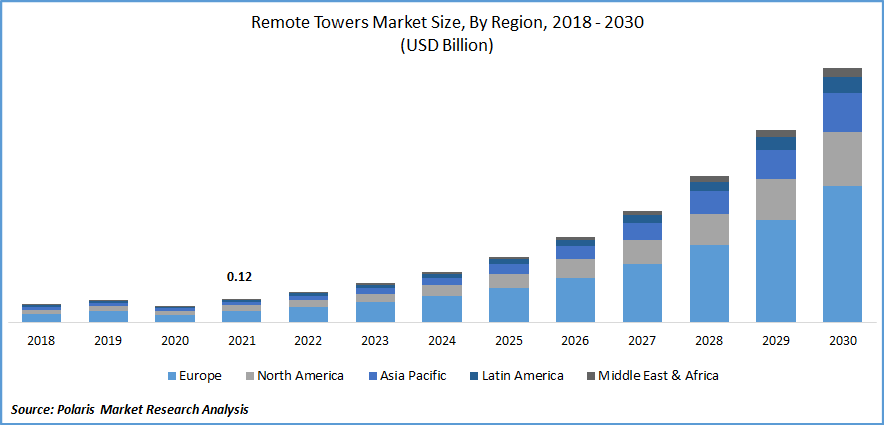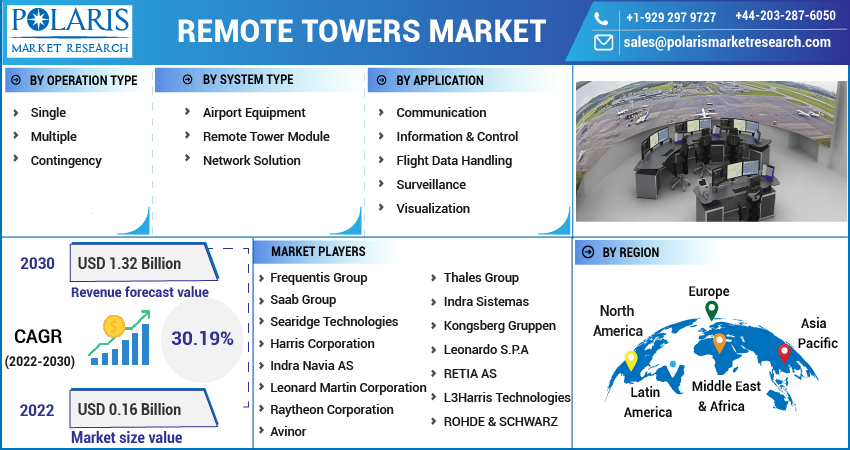
Remote Towers Market Share, Size, Trends, Industry Analysis Report, By Operation Type (Single Multiple and Contingency); By System Type (Airport Equipment, Remote Towers Modules, Network Solutions); By Application; By Region; Segment Forecast, 2022 - 2030
- Published Date:Nov-2022
- Pages: 118
- Format: PDF
- Report ID: PM2755
- Base Year: 2021
- Historical Data: 2018-2020
Report Outlook
The global remote towers market was valued at USD 0.12 billion in 2021 and is expected to grow at a CAGR of 30.19% during the forecast period.
The demand for the remote tower is expanding due to increased attempts to lower the cost of air traffic control, including the opening of more new airports and the development of existing airports around the world. The aviation industry has seen rapid growth all over the world. This is mostly because there are more people traveling by air thanks to lower flying costs in many nations.

Know more about this report: Request for sample pages
Remote towers can manage one airport or several airports from a distance. Air traffic control systems and civil infrastructure are less expensive when remote towers are used. Small and medium-sized airports with low traffic volumes cannot operate profitably due to expensive air tower costs. The remote tower systems may manage and control several airports concurrently and sequentially from a single place. As a result, many nations are using remote tower services for their air traffic management procedures. Such factors will drive the market's growth in the forecast period.
An airport's standard ATC tower cannot provide air traffic control services remotely, so a remote tower is used instead. High-definition cameras, sensors, microphones, and a local processing system are used to administer the services. The air traffic controller can offer the same ATC services as if seated in the traditional tower, thanks to the Remote Tower Centre's hardware controllers and screens. It makes it possible to combine the activities of multiple airports into a single remote tower center.

For Specific Research Requirements, Request for a Customized Report
Industry Dynamics
Growth Drivers
There has been strong growth in many regions of the aviation industry in recent years. With the low fares provided by the airlines in many nations, this recent development is increasing the number of passengers flying. It is projected that the need for freight services and virtual towers will expand along with the demand for air travel. In 2018, international airlines carried more than 4.3 billion people yearly, and it is anticipated that this number will reach over 7.2 billion passengers by 2035, according to a report from the International Air Transport Association (IATA).
Additionally, 58 million tonnes of freight were carried or moved by airplanes worldwide. The expansion and development of airport infrastructure are attracting investments from around the world. The International Air Transport Association (IATA) estimates that by 2030, over USD 1.5 trillion will be invested in expanding airport construction, modernization, and development worldwide. During the anticipated timeframe, these variables are projected to present many prospects for market expansion.
Report Segmentation
The market is primarily segmented based on operation type, system type, application, and region.
|
By Operation Type |
By System Type |
By Application |
By Region |
|
|
|
|
Know more about this report: Request for sample pages
The Contingency segment is expected to witness the fastest growth.
In 2021, the Contingency sub-segment was anticipated to grow rapidly throughout the projected period. Due to increasing flight traffic at Tier One airports and increasing usage of technology like artificial intelligence (AI) and machine learning to streamline processes in airports, the contingency operation type is the remote towers market segment that is developing at the fastest rate. In this mode, ATS is provided from a permanent digital tower facility without using a conventional tower. In the forecast period, these factors will contribute to the growth of the remote tower operation segment.
Remote Tower Module accounted for the second-largest market share in 2021
Remote Tower Module will account for a large portion of the market in the upcoming years. Because of its durability and adaptability, concrete is a common building material. Concrete is a natural substance and will deteriorate over time while being strong. For ornamental purposes, concrete is currently widely used in both residential and non-residential buildings. Concrete grinding is the process of utilizing abrasive tools to smooth out the floor's surface. Since they do not leave ridges on the floor surface, floor grinding machines are considered superior to scarifies and shot blasters.
Additionally, they eliminate stains, grease, spots, and industrial impurities and enable the production of flat joints. The uniform base for floor polishing, staining, and sealing is created by clearing the components. Concrete grinding machines contain discs that rotate horizontally and have a variety of attachments that vary in kind and grit depending on the use. on the same network.
The Flight Data Handling segment is expected to witness the fastest growth
It is anticipated that the flight data segment will increase at a sizable CAGR over the forecast period. These systems control the air traffic on several thousand flights regularly. During the coming years, developing countries with limited resources will likely drive demand for distant towers owing to their increased cost-saving benefits. The market is expected to grow during the forecast period.
The demand in Europe is expected to witness significant growth
The global market is expected to dominate Europe during the forecast period. Although the development of more advanced and technologically advanced remote tower components, such as high-resolution cameras and panoramic displays, as well as communication systems, is predicted to drive the market in this area.
Norway opens the world's largest Remote Towers Center. This is the outcome of Avinor and KONGSBERG's cooperation. The businesses have built a framework that will boost the aviation industry by utilizing complementary areas of knowledge. Digitalization will influence Norway's future, and the aviation industry will set the pace. Furthermore, this is expected to dominate the European market during the anticipated period.
Competitive Insight
Some of the major players in the global market, such as Frequentis Group, Raytheon Technologies, Saab Group, Searidge Technologies, Harris Corporation, Indra Navia AS, Leonard Martin Corporation, Avinor, Thales Group, Indra Sistemas, Kongsberg Gruppen, Northrop Grumman, RETIA AS, L3Harris Technologies, ROHDE & SCHWARZ, and others.
Recent Developments
In May 2022, In Braunschweig, Germany, the German Aerospace Center (DLR) and DFS Aviation Services GmbH (DAS) signed an agreement to conduct joint research on remote airport monitoring.
In April 2019, in collaboration with German air navigation provider Deutsche Flugsicherung DFS, Frequentis entered this joint venture. In this partnership, the country's first remote tower will operate from a remote-control center around 450 km away in order to handle Saarbrucken Airport.
Remote Towers Market Report Scope
|
Report Attributes |
Details |
|
Market size value in 2022 |
USD 0.16 billion |
|
Revenue forecast in 2030 |
USD 1.32 billion |
|
CAGR |
30.19% from 2022 – 2030 |
|
Base year |
2021 |
|
Historical data |
2018 – 2020 |
|
Forecast period |
2022 – 2030 |
|
Quantitative units |
Revenue in USD billion and CAGR from 2022 to 2030 |
|
Segments Covered |
By Operation Type, By System Type, By Application, and By Region |
|
Regional scope |
North America, Europe, Asia Pacific, Latin America; Middle East & Africa |
|
Key Companies |
Frequentis Group, Saab Group, Searidge Technologies, Harris Corporation, Indra Navia AS, Leonard Martin Corporation, Raytheon Corporation, Avinor, Thales Group, Indra Sistemas, Kongsberg Gruppen, Leonardo S.P.A, Northrop Grumman Corporation, Raytheon Technologies Corporation, RETIA AS, L3Harris Technologies, ROHDE & SCHWARZ, DFS Deutsche Flugsicherung GmbH, and others. |
